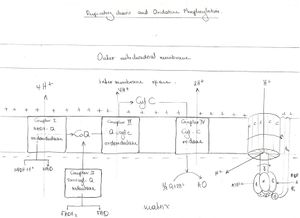Respiratory chain Oxidative phosphorylation
Respiratory chain and Oxidative phosphorylation[edit | edit source]
Respiratory chain[edit | edit source]
The repiratory chain is a collection of enzymes that induce the electrochemical gradient of protons (H+), necessary for the ATP synthesis. Fatty acid, amino acid and monosaccharide metabolism yields acetyl-CoA, a molecule that is oxidized in the Citric acid cycle producing reduced coenzymes (NADH+H+, FADH2) and GTP. These coenzymes are subsequently collected and transported by the repsiratory chain, directing them to their final reaction with O2 to form H2O. The respiratory chain consists of enzymes that are found only in the inner membrane of mitochondria, thus only mitochondrion-containing cells are able to produce energy through oxidative phosphorylation (aerobic respiration). Mitochodrionless cells, such as erythrocytes, produce energy only through glycolysis, an anaerobic process of glucose oxidation into pyruvate.
Oxidative phosphorylation[edit | edit source]
It is the process through which the liberated free energy provided by the electrochemical gradient of protons (H+), is trapped as high energy phosphate. The electrochemical built-up of hydrogen ions, by the respiratory chain is used to drive protons through an enzyme called ATP synthase. The kinetic energy of protons is used by the synthase to store energy as high energy phosphate in ATP by binding ADP and Pi.
Components of the respiratory chain[edit | edit source]
Electrons flow through the repsiratory chain, passing through three large protein enzyme complexes.
- NADH-Q oxidoreductase/Complex I: the electrons are transported from the NADH+H+ to coenzyme Q
- Q-Cytochorme c oxidoreductase/Complex III: coenzyme Q passes the electrons to the cytochrome c
- Cytochrome c oxidase/Complex IV:completes the chain, passing the electrons to O2 and causing it to be reduced to H2O
- Succinate-Q reductase/Complex II:the electrons are transferred from FADH2 to coenzyme Q
The flow of electrons through the respiratory chain generates ATP through the process of oxidative phosphorylation. Enzyme complexes I, III and IV act as proton pumps which cause the accumulation of protons in the intermembrane space of mitochondria constituting it more positive than the intramembrane space (matrix) which becomes progressively more negative building an electrochemical gradient with protons hving the tendency to return back into the matrix which is more negative. The only way to do that is passing through the ATP synthase which exploits their energy to form ATP.
Inhibitors[edit | edit source]
Inhibitors of the respiratory chain:
- Barbiturates: they inhibit complex I/NADH-Q oxidoreductase, preventing electron transfer from NADH+H+ to coenzyme Q
- CO2, H2S and CN-: they inhibit complex IV/cytochrome c oxidase preventing reduction of O2 to H2O
- Antimycin A: it inhibits complex III/Q-cytochrome c oxidoreductase preventing transfer of electrons from CoQ to cyt c.
Inhibitors of the oxidative phosphorylation: atractyloside which inhibits ATP synthase by blocking the flow of protons through the F0 subunit. Uncouplers of oxidative phosphorylation: 2,4 dinitrophenol which uncouples proton pumping from ATP synthesis because it carries protons across the inner mitochondrial membrane (no ATP synthase inhibiton, rather elimination of the proton electrochemical gradient built-up)
Links[edit | edit source]
Bibliography[edit | edit source]
MURRAY, Robert K. – BENDER, David A.. Harper's Illustrated Biochemistry. 29th edition. McGraw-Hill Companies, Inc., 2012. ISBN 978-0-07-176576-3.


